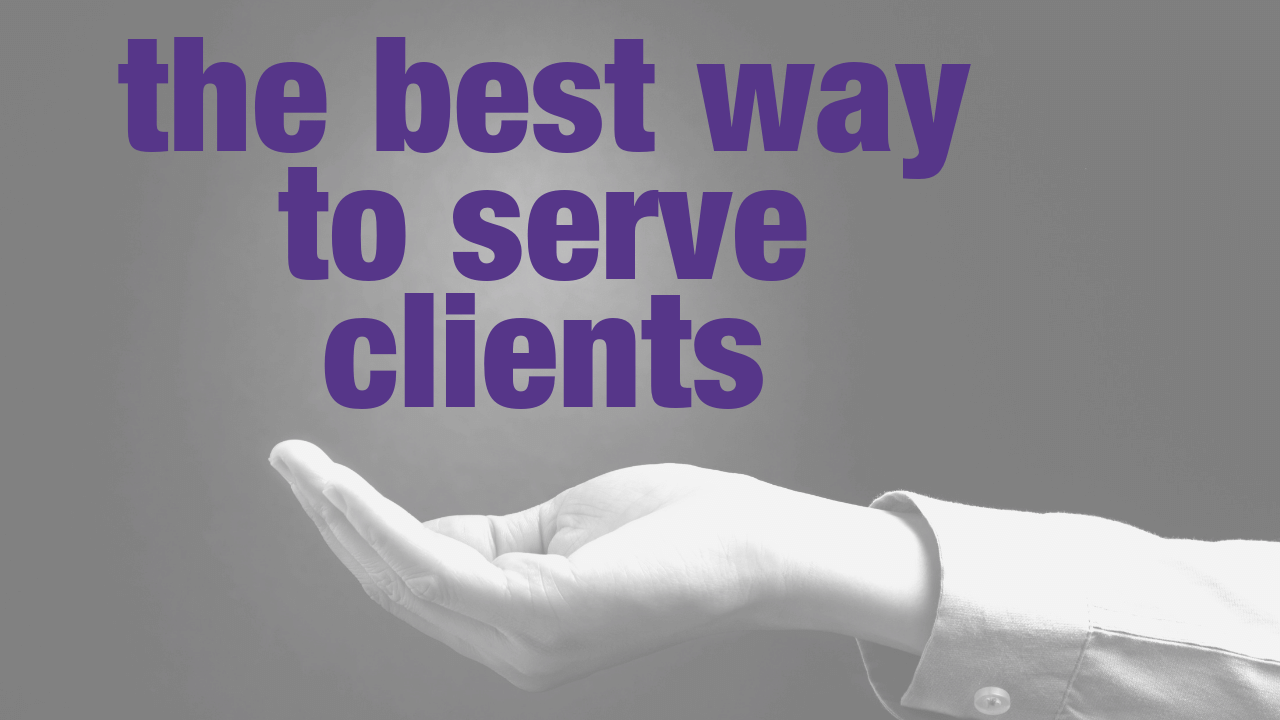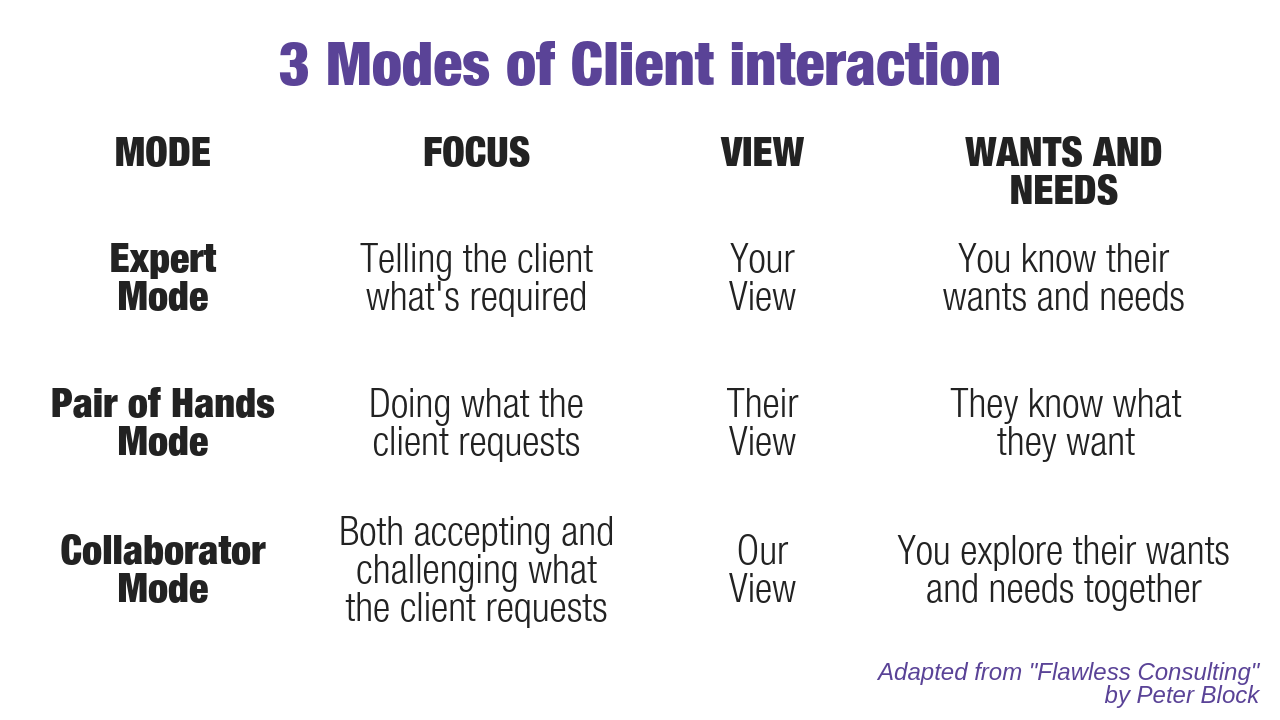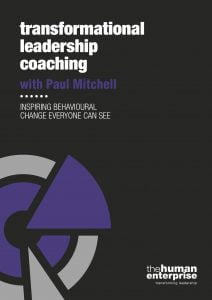
If your role involves serving clients, and let’s face it, whose role doesn’t have internal or external clients, then part of you should want to “please” them. Important as this is, is it really the best thing for your clients?
The space of service
Dr Barry Oshry, in his work on Seeing Systems says because we want to serve, want to feel and be useful, we tend to offer solutions far too early. We want to be of immediate value. To be seen as an expert or as someone who is “service” oriented.
In a way, this is saying more about us wanting to be SEEN as adding value, rather than actually adding value to your clients. Like all of us, clients have certain ways of thinking and doing things. Most of which have served them well over the years. They’re falling back on “the way we do it around here” gives them a sense of certainty and predictability but it may not necessarily be the best thing for them in the long-term.
Going with the flow
Our tendency is often to agree with what clients are saying, re-confirming their world views, reinforcing their identity, and their stated needs. This way it’s easier. You can avoid most conflicts and then figure out ways to give your client what they want, what they are asking for.
But as one of my favourite Shakespeare quotes goes:
“Ay, there’s the rub!”
From Hamlet
Are you really helping if you simply give clients what they WANT rather than what they NEED? And who decides that anyway?
For example, I may want to sleep in of a morning but what I really need is to get up and exercise. I may really want a comfortable lifestyle but to keep growing, what I really need are new challenges.
Modes of Client Interface
Giving clients what they want or what they need often depends on the mode in which you choose to work with them in the first place.
By the way, in case you think I’ve gone a bit binary here, not at all. You can actually give clients both what they want and what they need. I’m simply saying we tend to initially provide what they want too quickly.
So what can you do? You could see yourself as a consultant: either external or internal. By doing this, you can more easily become conscious of your typical way of “serving” clients and simultaneously challenge your effectiveness. Peter Block, in Flawless Consulting, gives us the three main ways we can work with clients. All have their merits and drawbacks regarding needs and wants.

The Energy required
Each of the above modes of interaction require certain amounts of energy and all three modes could be instigated with any client after any request or project involvement.
The Collaborator Mode
Today, I want to focus on the collaborator mode and in particular one aspect of it. It’s an aspect that will initially give you the greatest discomfort yet in the long run, it will gain the greatest successes for your clients.
Your key to really serving clients
The key with the collaborator mode is to be a “provocateur”. To continually ask provocative questions that often make both you and your clients uncomfortable.
Why? Because in some ways you are directly challenging “the way we do it around here” and indirectly, your clients themselves. If your “pleaser” part is far too prevalent, you’re going to really find this difficult in the short-term.
I’ll be the first to admit, I did this with my own clients in the early days of my consulting career. I was afraid of the potential conflict, afraid they would not hire me, afraid they would “reject” me. It was too much of a blow to my more fragile ego at the time and I had to make the mortgage repayments.
Nowadays, I know my external objectivity and “challenge” is one of the greatest gifts I can give my clients.
How do you challenge?
First of all, I believe you need to earn the right to challenge. You do this by building rapport, asking smart questions about their current context, listening for stated wants while also tracking for unspoken needs.
On various workshops and team days, I’ll often challenge clients on such issues as required attire, the timings on the programme, free time, breaks, themes, processes, who should attend, context, agenda items and myriad other factors.
At other times it may go a lot deeper, like asking clients how they are contributing to the problem, or challenging them that their problems are not their problems. It’s their inability to solve their own problems that’s the real problem. Or even how the behaviour of executives is way out of line with their stated values.
The danger of this approach
There are a couple of “dangers” to watch out for.
You have to make sure you’re really coming from the right place. That it’s the “space” or “place” of service. No one loves a smart arse or someone on a power trip. Even if your questions come from the right place, they may not always land that way.
This is the risk you take. In my Transformational Leadership Coaching, I am deliberately quite provocative. I challenge my clients’ very value systems, their beliefs, their story, their world view.
That’s not easy to swallow at times, but if you shut up, stop talking and “let the tension rise”, it’s amazing just what can come to the surface: new thinking, new awareness, new freedom, new energy and new possibilities.
The short and the long run
In the short-term, although the tension rises and it feels like you are in conflict, and the client gives you unappreciative glares, they will mostly come to really respect your challenging over time.
And if you don’t challenge, who will? Particularly if they are a very Senior Executive.
Your “personal brand” will be enhanced as someone who really wants to make a difference, not just maintain the status quo.
“If you always do what you’ve always done,
you’ll always get what you’ve always got.”
Henry Ford
Yet even more importantly…
You feel good about you. You’ll know you have come from a place of pure service, putting the client wants and needs above your own needs of being accepted and being of immediate value. You demonstrate the courage to be disliked. Because of this, over the years you’ll get stronger and stronger. You’ll feel better and better about you. You will respect you.
“This above all: to thine own self be true”
Shakespeare (from Hamlet)
So, what’s the provocation you need to ask your clients today?
Small Tweaks
- Build rapport with your clients.
- Stay in the service space of listening and paraphrasing.
- Ask for permission, if you think it’s necessary, to raise the tough questions.
- Ask questions that “provoke” new thinking about such issues as their way of doing business, their values, their story and their identity.
- Ask your questions, shut up and let the tension rise.
- Explore the difference between wants and needs.
- Go for it, make bold needs statements of what you believe is required and see what happens.
- Handle the push back.
- Point out their intensity of emotion if they do push back.
- Ask them to think about it.
- Follow up.
- Check your own need to be accepted or liked versus being respected.
I originally wrote this article for inclusion in a new collection of my writing called Rough Diamonds: A collection of Leadership Gems from the Vault. Currently, the only way to get the whole collection is by purchasing my book Your Leadership Diamond. When you enter your order number via the link below, you’ll get Rough Diamonds as well as the whole audiobook of Your Leadership Diamond, narrated by yours truly, for FREE. CLICK HERE TO GET YOUR COPY NOW.
Until next time…
Find the passion.
Develop the skills.
Make the numbers.
Make a difference.

Paul Mitchell
“APAC’s most respected transformational leadership performance coach”
Paul Mitchell (@Paul_S_Mitchell) is a speaker, author, transformational leadership coach and founder of the human enterprise. Through leadership coaching, leadership development programmes, keynotes and facilitation, Paul works with organisations to build cultures where everybody leads.
Looking for coaching for yourself or one of your leaders? Coaching that does more than just go through the motions? That challenges you to be the best you can be? I invite you to explore Transformational Leadership Coaching and be challenged by myself and your key stakeholders, the real coaches around you. “I wanted someone who was going to help me be a great leader not just a better manager. I contacted Paul because I knew of other Senior Leaders who saw him as a “game changer”. I didn’t want to take the long way to my goals. I wanted to invest in the best. That investment has paid off enormously, through his balance of constant challenging and support.” Sujith Abraham, Group Vice President, Asia Pacific Strategy & Sales Development at Oracle

(Correct title at time of testimonial given)

